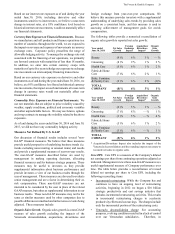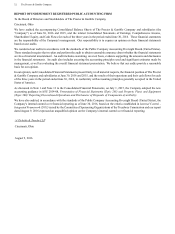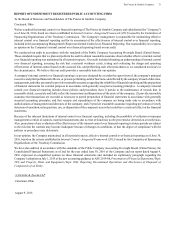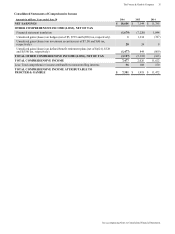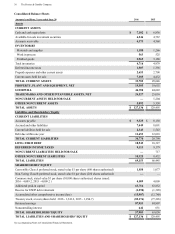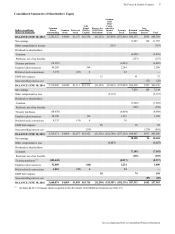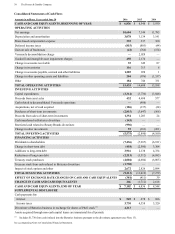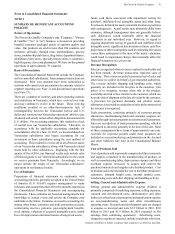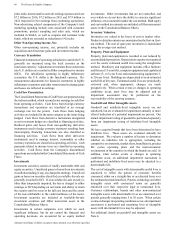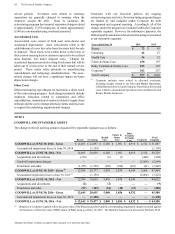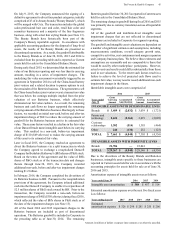Proctor and Gamble 2016 Annual Report Download - page 53
Download and view the complete annual report
Please find page 53 of the 2016 Proctor and Gamble annual report below. You can navigate through the pages in the report by either clicking on the pages listed below, or by using the keyword search tool below to find specific information within the annual report.The Procter & Gamble Company 39
Amounts in millions of dollars except per share amounts or as otherwise specified.
Notes to Consolidated Financial Statements
NOTE 1
SUMMARY OF SIGNIFICANT ACCOUNTING
POLICIES
Nature of Operations
The Procter & Gamble Company's (the "Company," "Procter
& Gamble," "we" or "us") business is focused on providing
branded consumer packaged goods of superior quality and
value. Our products are sold in more than 180 countries and
territories primarily through mass merchandisers, grocery
stores, membership club stores, drug stores, department stores,
distributors, baby stores, specialty beauty stores, e-commerce,
high-frequency stores and pharmacies. We have on-the-ground
operations in approximately 70 countries.
Basis of Presentation
The Consolidated Financial Statements include the Company
and its controlled subsidiaries. Intercompany transactions are
eliminated. Prior year amounts have been reclassified to
conform with current year presentation for amounts related to
segment reporting (see Note 2) and discontinued operations
(see Note 13).
There are a number of currency and other operating controls
and restrictions in Venezuela, which have evolved over time
and may continue to evolve in the future. These evolving
conditions resulted in an other-than-temporary lack of
exchangeability between the Venezuelan bolivar and U.S.
dollar and restricted our Venezuelan operations’ ability to pay
dividends and satisfy certain other obligations denominated in
U.S. dollars. For accounting purposes, this resulted in a lack
of control over our Venezuelan subsidiaries. Therefore, in
accordance with the applicable accounting standards for
consolidation, effective June 30, 2015, we deconsolidated our
Venezuelan subsidiaries and began accounting for our
investment in those subsidiaries using the cost method of
accounting. This resulted in a write-off of all of the net assets
of our Venezuelan subsidiaries, along with Venezuela related
assets held by other subsidiaries. Beginning with the first
quarter of fiscal 2016, our financial results only include sales
of finished goods to our Venezuelan subsidiaries to the extent
we receive payments from Venezuela. Accordingly, we no
longer include the results of our Venezuelan subsidiaries’
operations in our financial results.
Use of Estimates
Preparation of financial statements in conformity with
accounting principles generally accepted in the United States
of America (U.S. GAAP) requires management to make
estimates and assumptions that affect the amounts reported in
the Consolidated Financial Statements and accompanying
disclosures. These estimates are based on management's best
knowledge of current events and actions the Company may
undertake in the future. Estimates are used in accounting for,
among other items, consumer and trade promotion accruals,
restructuring reserves, pensions, post-employment benefits,
stock options, valuation of acquired intangible assets, useful
lives for depreciation and amortization of long-lived assets,
future cash flows associated with impairment testing for
goodwill, indefinite-lived intangible assets and other long-
lived assets, deferred tax assets, uncertain income tax positions
and contingencies. Actual results may ultimately differ from
estimates, although management does not generally believe
such differences would materially affect the financial
statements in any individual year. However, in regard to
ongoing impairment testing of goodwill and indefinite-lived
intangible assets, significant deterioration in future cash flow
projections or other assumptions used in estimating fair values
versus those anticipated at the time of the initial valuations,
could result in impairment charges that materially affect the
financial statements in a given year.
Revenue Recognition
Sales are recognized when revenue is realized or realizable and
has been earned. Revenue transactions represent sales of
inventory. The revenue recorded is presented net of sales and
other taxes we collect on behalf of governmental authorities.
The revenue includes shipping and handling costs, which
generally are included in the list price to the customer. Our
policy is to recognize revenue when title to the product,
ownership and risk of loss transfer to the customer, which can
be on the date of shipment or the date of receipt by the customer.
A provision for payment discounts and product return
allowances is recorded as a reduction of sales in the same period
the revenue is recognized.
Trade promotions, consisting primarily of customer pricing
allowances, merchandising funds and consumer coupons, are
offered through various programs to customers and consumers.
Sales are recorded net of trade promotion spending, which is
recognized as incurred, generally at the time of the sale. Most
of these arrangements have terms of approximately one year.
Accruals for expected payouts under these programs are
included as accrued marketing and promotion in the Accrued
and other liabilities line item in the Consolidated Balance
Sheets.
Cost of Products Sold
Cost of products sold is primarily comprised of direct materials
and supplies consumed in the manufacturing of product, as
well as manufacturing labor, depreciation expense and direct
overhead expense necessary to acquire and convert the
purchased materials and supplies into finished product. Cost
of products sold also includes the cost to distribute products to
customers, inbound freight costs, internal transfer costs,
warehousing costs and other shipping and handling activity.
Selling, General and Administrative Expense
Selling, general and administrative expense (SG&A) is
primarily comprised of marketing expenses, selling expenses,
research and development costs, administrative and other
indirect overhead costs, depreciation and amortization expense
on non-manufacturing assets and other miscellaneous
operating items. Research and development costs are charged
to expense as incurred and were $1.9 billion in 2016, $2.0
billion in 2015 and $1.9 billion in 2014 (reported in Net
earnings from continuing operations). Advertising costs,
charged to expense as incurred, include worldwide television,


